Reflection on Roper-Logan-Tierney Model of Living
VerifiedAdded on 2023/03/23
|8
|1987
|61
AI Summary
This reflection discusses the Roper-Logan-Tierney model of living and its impact on holistic care. It explores the five factors that influence daily living and how to incorporate them in care services. The reflection also highlights the importance of effective communication and providing comfort to patients and their families.
Contribute Materials
Your contribution can guide someone’s learning journey. Share your
documents today.
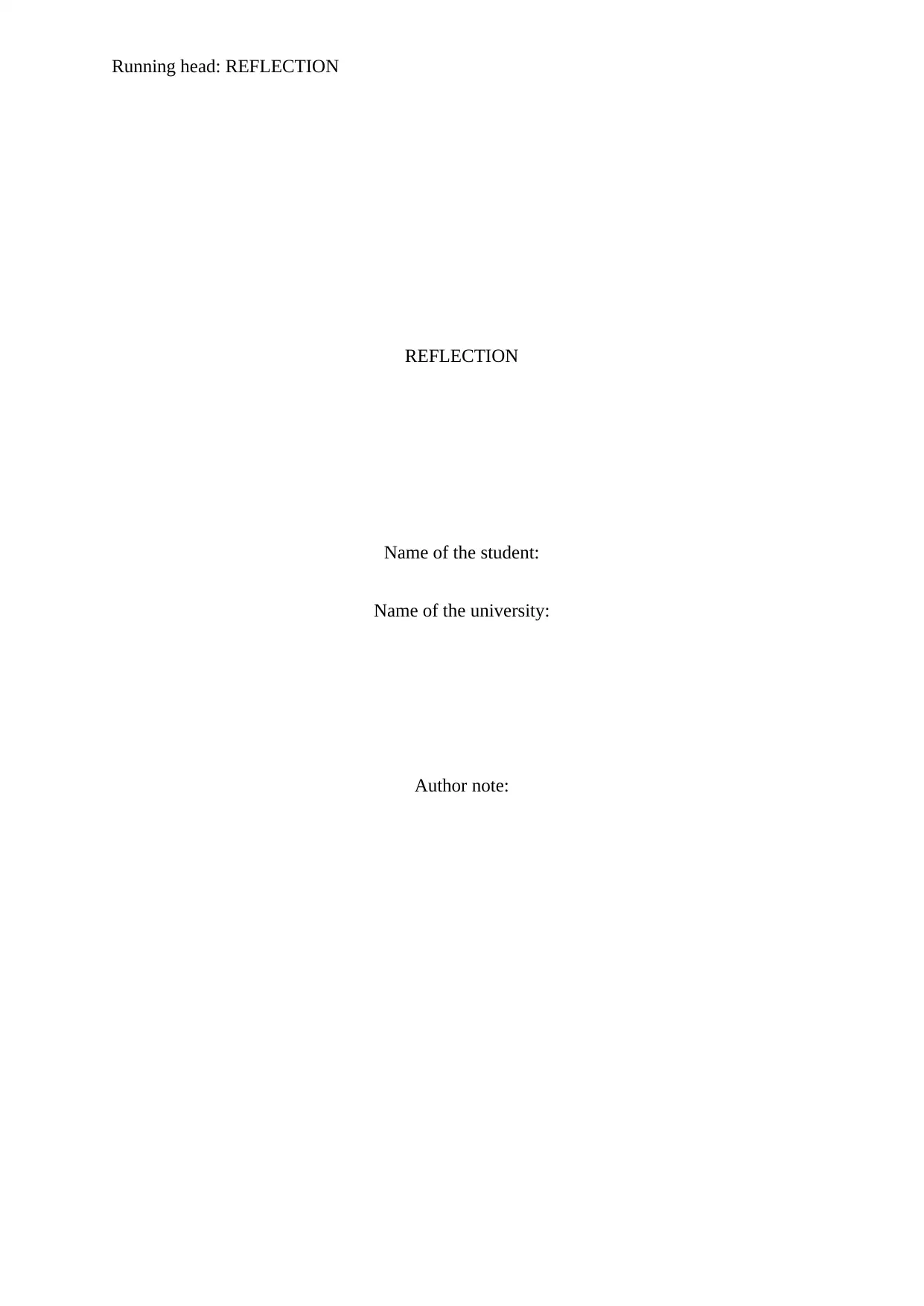
Running head: REFLECTION
REFLECTION
Name of the student:
Name of the university:
Author note:
REFLECTION
Name of the student:
Name of the university:
Author note:
Secure Best Marks with AI Grader
Need help grading? Try our AI Grader for instant feedback on your assignments.
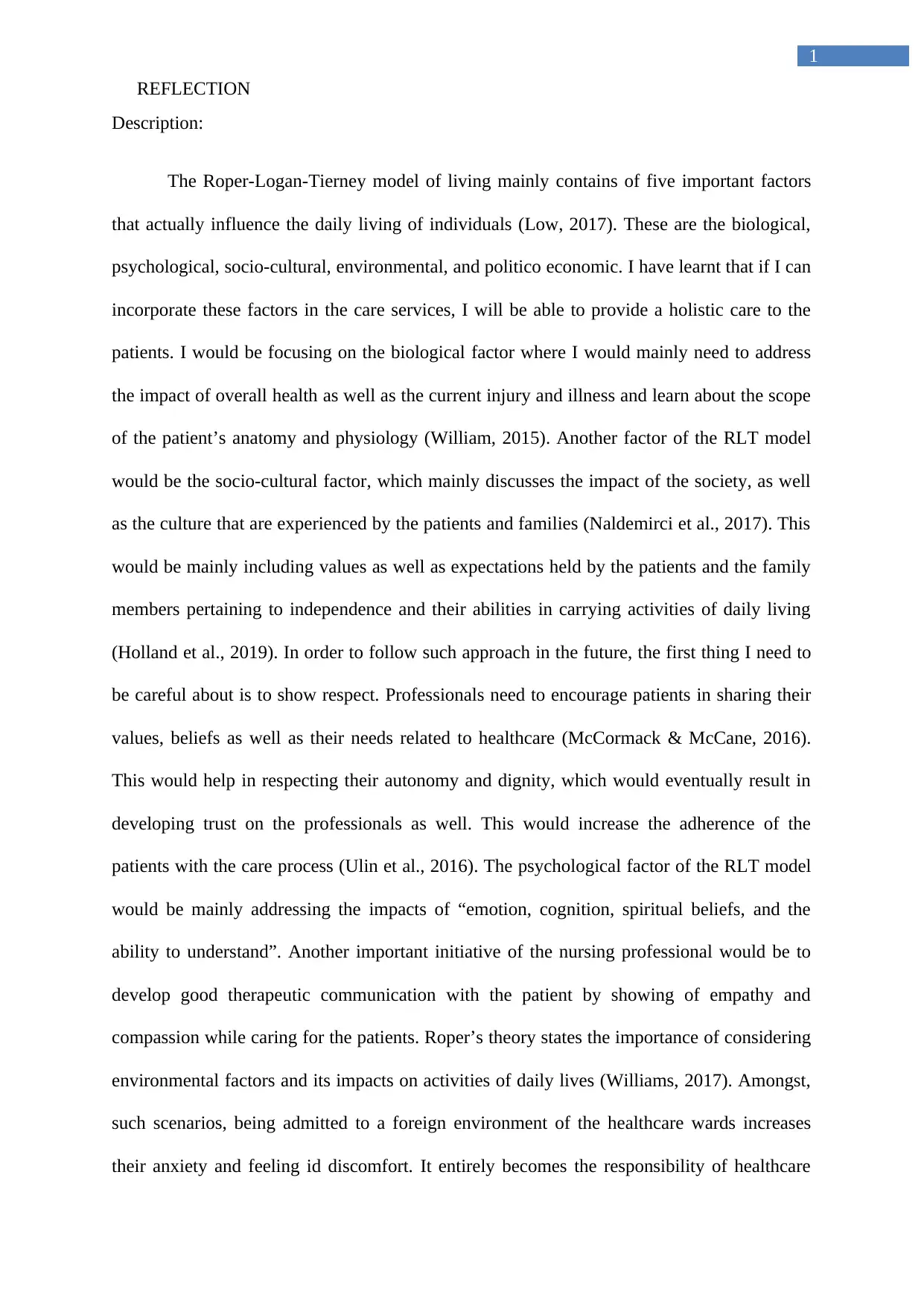
1
REFLECTION
Description:
The Roper-Logan-Tierney model of living mainly contains of five important factors
that actually influence the daily living of individuals (Low, 2017). These are the biological,
psychological, socio-cultural, environmental, and politico economic. I have learnt that if I can
incorporate these factors in the care services, I will be able to provide a holistic care to the
patients. I would be focusing on the biological factor where I would mainly need to address
the impact of overall health as well as the current injury and illness and learn about the scope
of the patient’s anatomy and physiology (William, 2015). Another factor of the RLT model
would be the socio-cultural factor, which mainly discusses the impact of the society, as well
as the culture that are experienced by the patients and families (Naldemirci et al., 2017). This
would be mainly including values as well as expectations held by the patients and the family
members pertaining to independence and their abilities in carrying activities of daily living
(Holland et al., 2019). In order to follow such approach in the future, the first thing I need to
be careful about is to show respect. Professionals need to encourage patients in sharing their
values, beliefs as well as their needs related to healthcare (McCormack & McCane, 2016).
This would help in respecting their autonomy and dignity, which would eventually result in
developing trust on the professionals as well. This would increase the adherence of the
patients with the care process (Ulin et al., 2016). The psychological factor of the RLT model
would be mainly addressing the impacts of “emotion, cognition, spiritual beliefs, and the
ability to understand”. Another important initiative of the nursing professional would be to
develop good therapeutic communication with the patient by showing of empathy and
compassion while caring for the patients. Roper’s theory states the importance of considering
environmental factors and its impacts on activities of daily lives (Williams, 2017). Amongst,
such scenarios, being admitted to a foreign environment of the healthcare wards increases
their anxiety and feeling id discomfort. It entirely becomes the responsibility of healthcare
REFLECTION
Description:
The Roper-Logan-Tierney model of living mainly contains of five important factors
that actually influence the daily living of individuals (Low, 2017). These are the biological,
psychological, socio-cultural, environmental, and politico economic. I have learnt that if I can
incorporate these factors in the care services, I will be able to provide a holistic care to the
patients. I would be focusing on the biological factor where I would mainly need to address
the impact of overall health as well as the current injury and illness and learn about the scope
of the patient’s anatomy and physiology (William, 2015). Another factor of the RLT model
would be the socio-cultural factor, which mainly discusses the impact of the society, as well
as the culture that are experienced by the patients and families (Naldemirci et al., 2017). This
would be mainly including values as well as expectations held by the patients and the family
members pertaining to independence and their abilities in carrying activities of daily living
(Holland et al., 2019). In order to follow such approach in the future, the first thing I need to
be careful about is to show respect. Professionals need to encourage patients in sharing their
values, beliefs as well as their needs related to healthcare (McCormack & McCane, 2016).
This would help in respecting their autonomy and dignity, which would eventually result in
developing trust on the professionals as well. This would increase the adherence of the
patients with the care process (Ulin et al., 2016). The psychological factor of the RLT model
would be mainly addressing the impacts of “emotion, cognition, spiritual beliefs, and the
ability to understand”. Another important initiative of the nursing professional would be to
develop good therapeutic communication with the patient by showing of empathy and
compassion while caring for the patients. Roper’s theory states the importance of considering
environmental factors and its impacts on activities of daily lives (Williams, 2017). Amongst,
such scenarios, being admitted to a foreign environment of the healthcare wards increases
their anxiety and feeling id discomfort. It entirely becomes the responsibility of healthcare
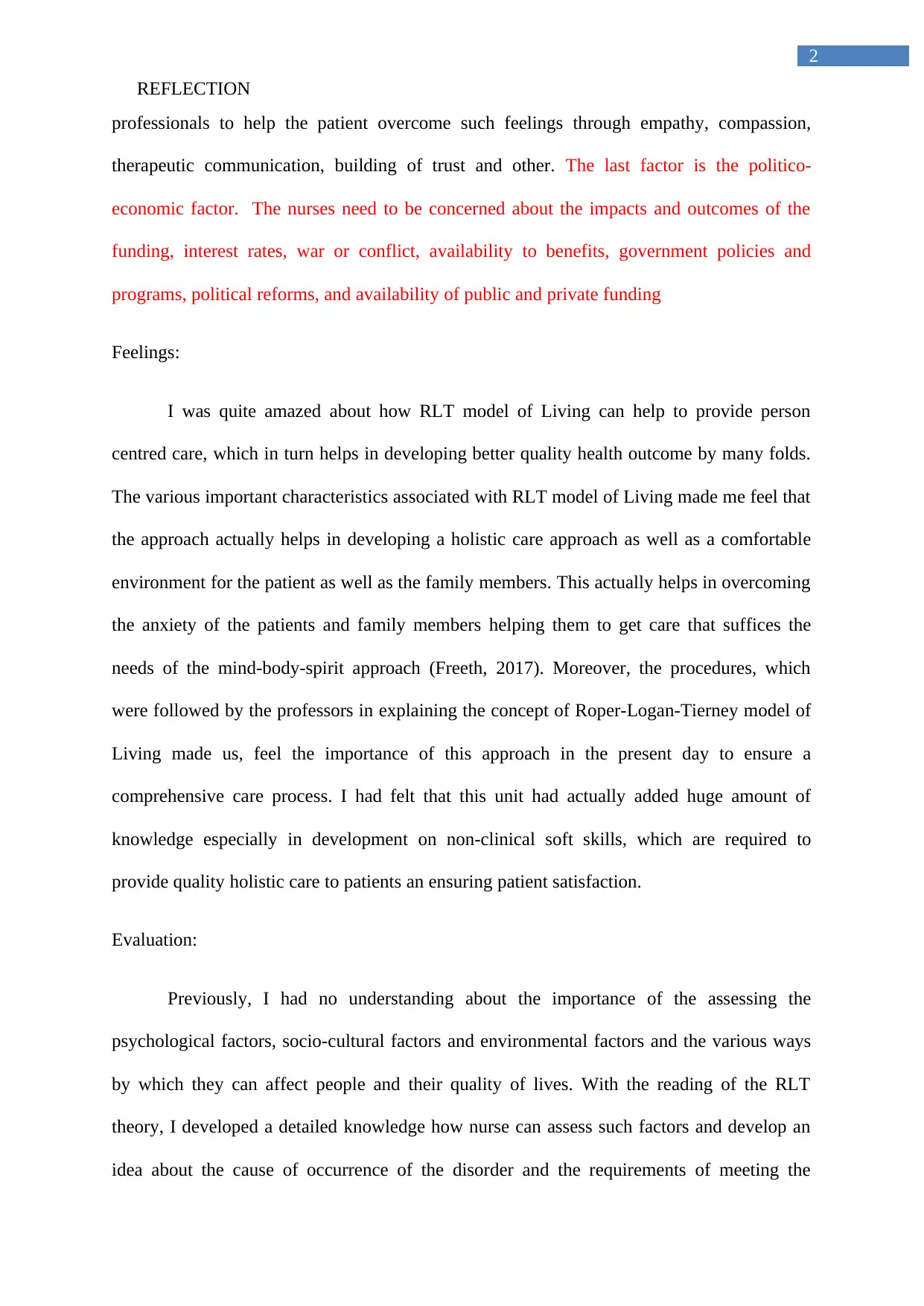
2
REFLECTION
professionals to help the patient overcome such feelings through empathy, compassion,
therapeutic communication, building of trust and other. The last factor is the politico-
economic factor. The nurses need to be concerned about the impacts and outcomes of the
funding, interest rates, war or conflict, availability to benefits, government policies and
programs, political reforms, and availability of public and private funding
Feelings:
I was quite amazed about how RLT model of Living can help to provide person
centred care, which in turn helps in developing better quality health outcome by many folds.
The various important characteristics associated with RLT model of Living made me feel that
the approach actually helps in developing a holistic care approach as well as a comfortable
environment for the patient as well as the family members. This actually helps in overcoming
the anxiety of the patients and family members helping them to get care that suffices the
needs of the mind-body-spirit approach (Freeth, 2017). Moreover, the procedures, which
were followed by the professors in explaining the concept of Roper-Logan-Tierney model of
Living made us, feel the importance of this approach in the present day to ensure a
comprehensive care process. I had felt that this unit had actually added huge amount of
knowledge especially in development on non-clinical soft skills, which are required to
provide quality holistic care to patients an ensuring patient satisfaction.
Evaluation:
Previously, I had no understanding about the importance of the assessing the
psychological factors, socio-cultural factors and environmental factors and the various ways
by which they can affect people and their quality of lives. With the reading of the RLT
theory, I developed a detailed knowledge how nurse can assess such factors and develop an
idea about the cause of occurrence of the disorder and the requirements of meeting the
REFLECTION
professionals to help the patient overcome such feelings through empathy, compassion,
therapeutic communication, building of trust and other. The last factor is the politico-
economic factor. The nurses need to be concerned about the impacts and outcomes of the
funding, interest rates, war or conflict, availability to benefits, government policies and
programs, political reforms, and availability of public and private funding
Feelings:
I was quite amazed about how RLT model of Living can help to provide person
centred care, which in turn helps in developing better quality health outcome by many folds.
The various important characteristics associated with RLT model of Living made me feel that
the approach actually helps in developing a holistic care approach as well as a comfortable
environment for the patient as well as the family members. This actually helps in overcoming
the anxiety of the patients and family members helping them to get care that suffices the
needs of the mind-body-spirit approach (Freeth, 2017). Moreover, the procedures, which
were followed by the professors in explaining the concept of Roper-Logan-Tierney model of
Living made us, feel the importance of this approach in the present day to ensure a
comprehensive care process. I had felt that this unit had actually added huge amount of
knowledge especially in development on non-clinical soft skills, which are required to
provide quality holistic care to patients an ensuring patient satisfaction.
Evaluation:
Previously, I had no understanding about the importance of the assessing the
psychological factors, socio-cultural factors and environmental factors and the various ways
by which they can affect people and their quality of lives. With the reading of the RLT
theory, I developed a detailed knowledge how nurse can assess such factors and develop an
idea about the cause of occurrence of the disorder and the requirements of meeting the
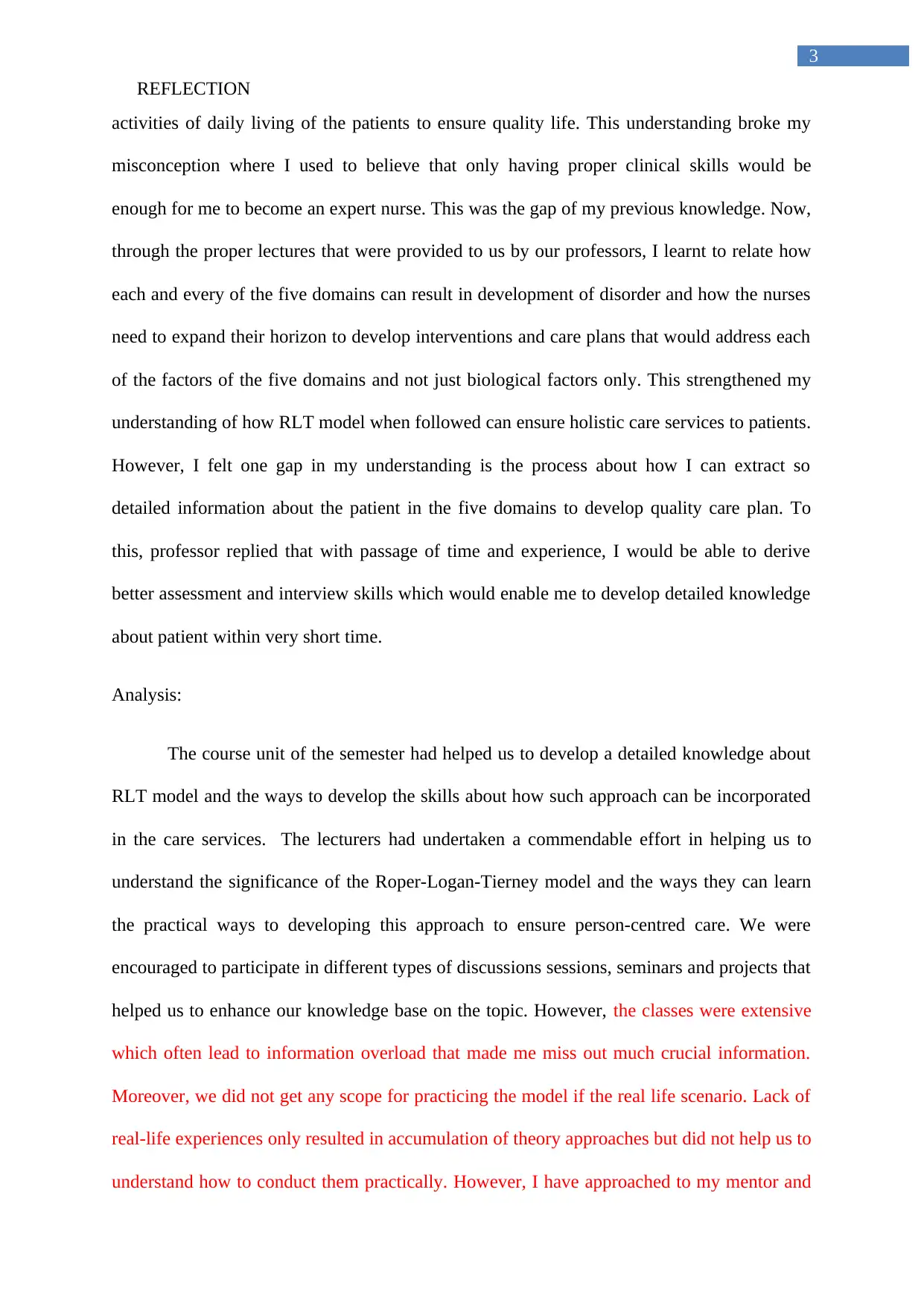
3
REFLECTION
activities of daily living of the patients to ensure quality life. This understanding broke my
misconception where I used to believe that only having proper clinical skills would be
enough for me to become an expert nurse. This was the gap of my previous knowledge. Now,
through the proper lectures that were provided to us by our professors, I learnt to relate how
each and every of the five domains can result in development of disorder and how the nurses
need to expand their horizon to develop interventions and care plans that would address each
of the factors of the five domains and not just biological factors only. This strengthened my
understanding of how RLT model when followed can ensure holistic care services to patients.
However, I felt one gap in my understanding is the process about how I can extract so
detailed information about the patient in the five domains to develop quality care plan. To
this, professor replied that with passage of time and experience, I would be able to derive
better assessment and interview skills which would enable me to develop detailed knowledge
about patient within very short time.
Analysis:
The course unit of the semester had helped us to develop a detailed knowledge about
RLT model and the ways to develop the skills about how such approach can be incorporated
in the care services. The lecturers had undertaken a commendable effort in helping us to
understand the significance of the Roper-Logan-Tierney model and the ways they can learn
the practical ways to developing this approach to ensure person-centred care. We were
encouraged to participate in different types of discussions sessions, seminars and projects that
helped us to enhance our knowledge base on the topic. However, the classes were extensive
which often lead to information overload that made me miss out much crucial information.
Moreover, we did not get any scope for practicing the model if the real life scenario. Lack of
real-life experiences only resulted in accumulation of theory approaches but did not help us to
understand how to conduct them practically. However, I have approached to my mentor and
REFLECTION
activities of daily living of the patients to ensure quality life. This understanding broke my
misconception where I used to believe that only having proper clinical skills would be
enough for me to become an expert nurse. This was the gap of my previous knowledge. Now,
through the proper lectures that were provided to us by our professors, I learnt to relate how
each and every of the five domains can result in development of disorder and how the nurses
need to expand their horizon to develop interventions and care plans that would address each
of the factors of the five domains and not just biological factors only. This strengthened my
understanding of how RLT model when followed can ensure holistic care services to patients.
However, I felt one gap in my understanding is the process about how I can extract so
detailed information about the patient in the five domains to develop quality care plan. To
this, professor replied that with passage of time and experience, I would be able to derive
better assessment and interview skills which would enable me to develop detailed knowledge
about patient within very short time.
Analysis:
The course unit of the semester had helped us to develop a detailed knowledge about
RLT model and the ways to develop the skills about how such approach can be incorporated
in the care services. The lecturers had undertaken a commendable effort in helping us to
understand the significance of the Roper-Logan-Tierney model and the ways they can learn
the practical ways to developing this approach to ensure person-centred care. We were
encouraged to participate in different types of discussions sessions, seminars and projects that
helped us to enhance our knowledge base on the topic. However, the classes were extensive
which often lead to information overload that made me miss out much crucial information.
Moreover, we did not get any scope for practicing the model if the real life scenario. Lack of
real-life experiences only resulted in accumulation of theory approaches but did not help us to
understand how to conduct them practically. However, I have approached to my mentor and
Secure Best Marks with AI Grader
Need help grading? Try our AI Grader for instant feedback on your assignments.
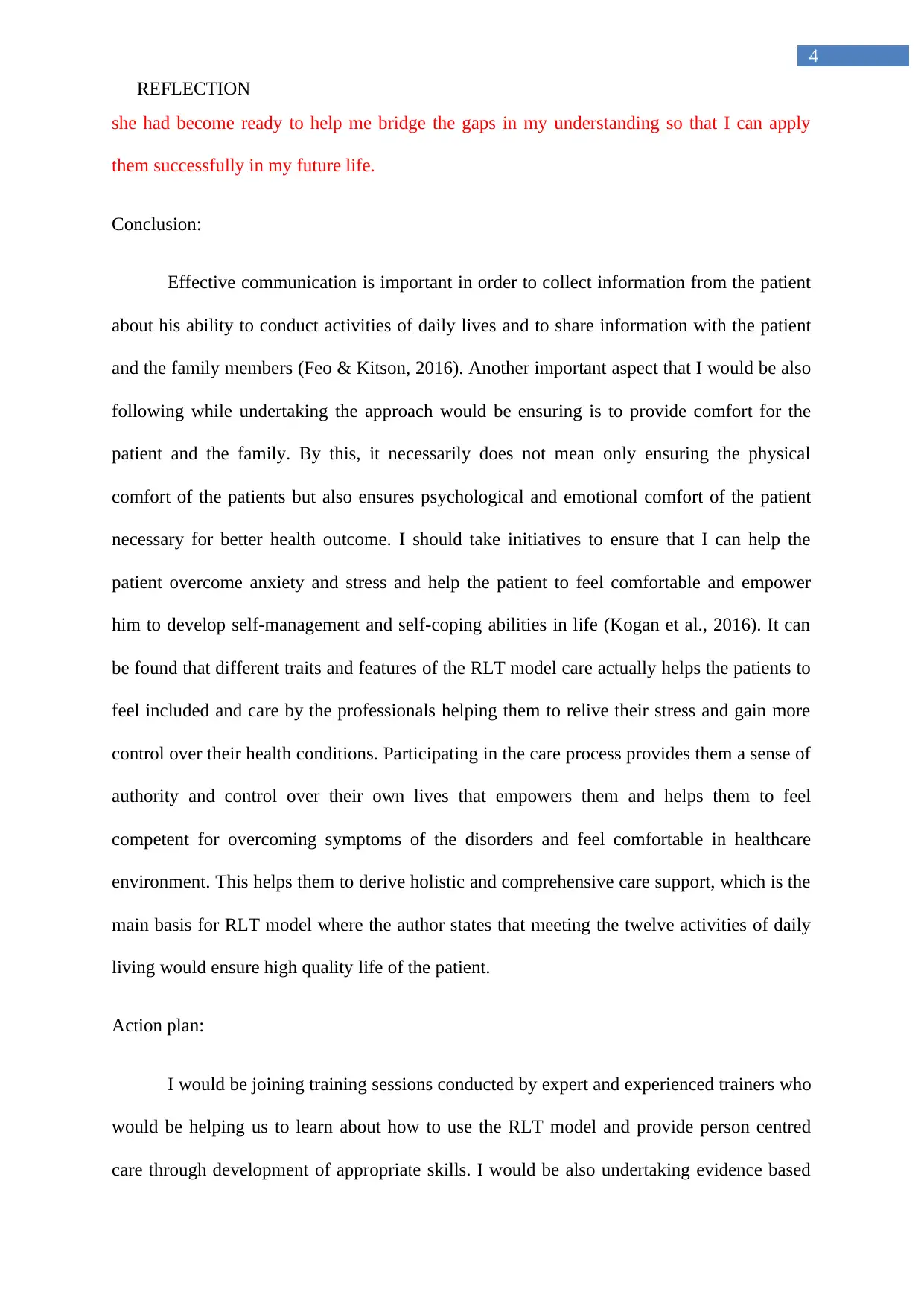
4
REFLECTION
she had become ready to help me bridge the gaps in my understanding so that I can apply
them successfully in my future life.
Conclusion:
Effective communication is important in order to collect information from the patient
about his ability to conduct activities of daily lives and to share information with the patient
and the family members (Feo & Kitson, 2016). Another important aspect that I would be also
following while undertaking the approach would be ensuring is to provide comfort for the
patient and the family. By this, it necessarily does not mean only ensuring the physical
comfort of the patients but also ensures psychological and emotional comfort of the patient
necessary for better health outcome. I should take initiatives to ensure that I can help the
patient overcome anxiety and stress and help the patient to feel comfortable and empower
him to develop self-management and self-coping abilities in life (Kogan et al., 2016). It can
be found that different traits and features of the RLT model care actually helps the patients to
feel included and care by the professionals helping them to relive their stress and gain more
control over their health conditions. Participating in the care process provides them a sense of
authority and control over their own lives that empowers them and helps them to feel
competent for overcoming symptoms of the disorders and feel comfortable in healthcare
environment. This helps them to derive holistic and comprehensive care support, which is the
main basis for RLT model where the author states that meeting the twelve activities of daily
living would ensure high quality life of the patient.
Action plan:
I would be joining training sessions conducted by expert and experienced trainers who
would be helping us to learn about how to use the RLT model and provide person centred
care through development of appropriate skills. I would be also undertaking evidence based
REFLECTION
she had become ready to help me bridge the gaps in my understanding so that I can apply
them successfully in my future life.
Conclusion:
Effective communication is important in order to collect information from the patient
about his ability to conduct activities of daily lives and to share information with the patient
and the family members (Feo & Kitson, 2016). Another important aspect that I would be also
following while undertaking the approach would be ensuring is to provide comfort for the
patient and the family. By this, it necessarily does not mean only ensuring the physical
comfort of the patients but also ensures psychological and emotional comfort of the patient
necessary for better health outcome. I should take initiatives to ensure that I can help the
patient overcome anxiety and stress and help the patient to feel comfortable and empower
him to develop self-management and self-coping abilities in life (Kogan et al., 2016). It can
be found that different traits and features of the RLT model care actually helps the patients to
feel included and care by the professionals helping them to relive their stress and gain more
control over their health conditions. Participating in the care process provides them a sense of
authority and control over their own lives that empowers them and helps them to feel
competent for overcoming symptoms of the disorders and feel comfortable in healthcare
environment. This helps them to derive holistic and comprehensive care support, which is the
main basis for RLT model where the author states that meeting the twelve activities of daily
living would ensure high quality life of the patient.
Action plan:
I would be joining training sessions conducted by expert and experienced trainers who
would be helping us to learn about how to use the RLT model and provide person centred
care through development of appropriate skills. I would be also undertaking evidence based
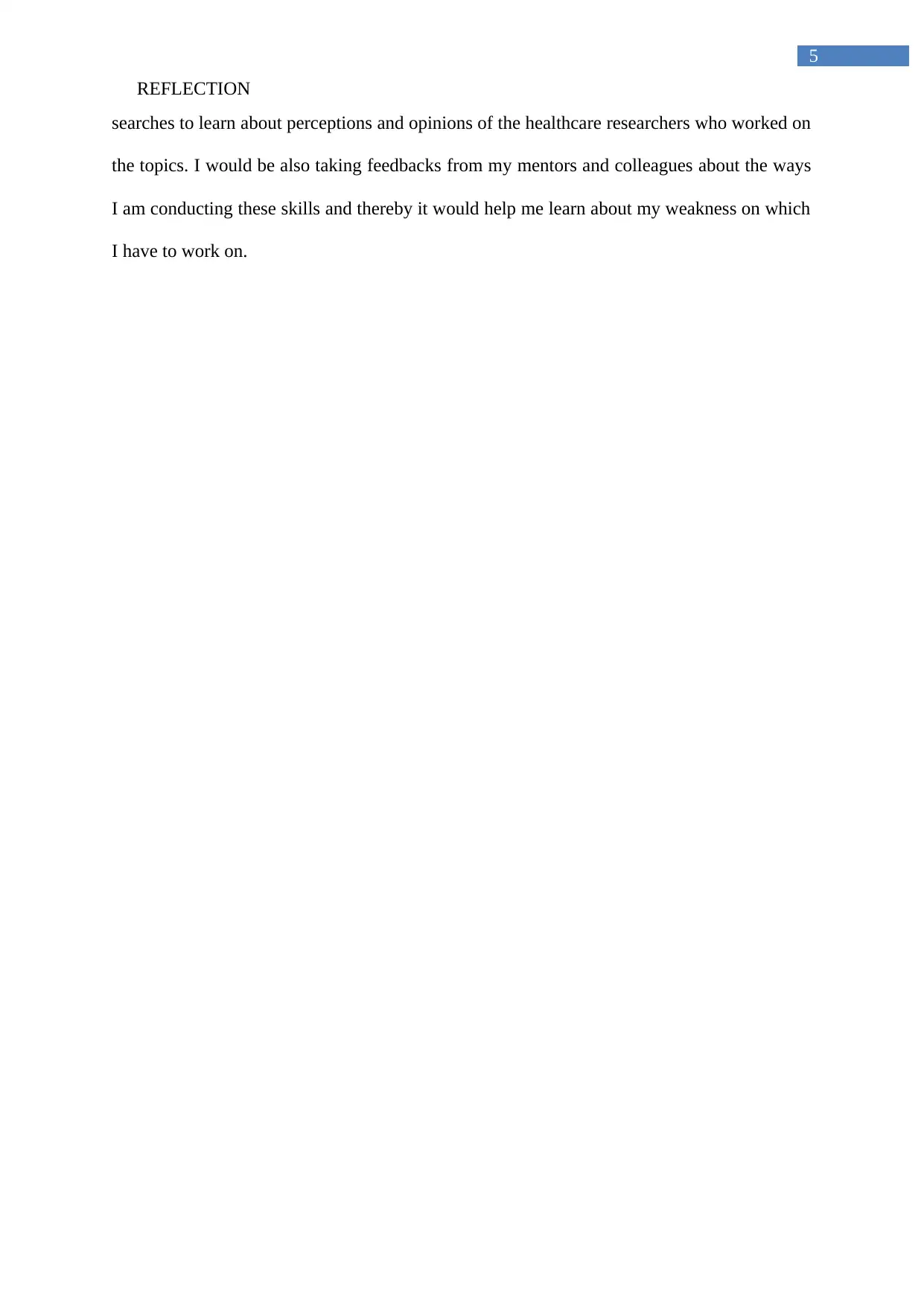
5
REFLECTION
searches to learn about perceptions and opinions of the healthcare researchers who worked on
the topics. I would be also taking feedbacks from my mentors and colleagues about the ways
I am conducting these skills and thereby it would help me learn about my weakness on which
I have to work on.
REFLECTION
searches to learn about perceptions and opinions of the healthcare researchers who worked on
the topics. I would be also taking feedbacks from my mentors and colleagues about the ways
I am conducting these skills and thereby it would help me learn about my weakness on which
I have to work on.
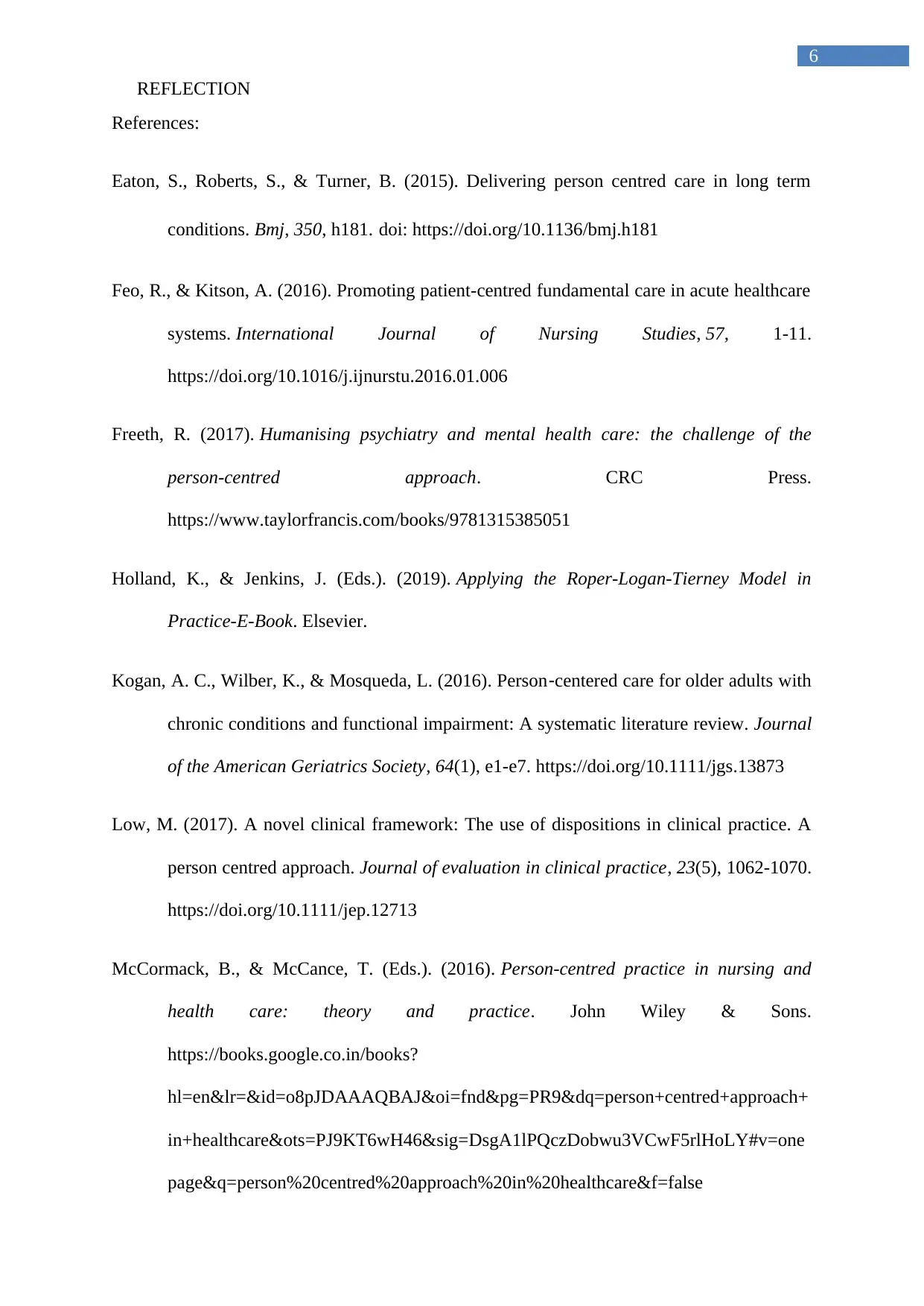
6
REFLECTION
References:
Eaton, S., Roberts, S., & Turner, B. (2015). Delivering person centred care in long term
conditions. Bmj, 350, h181. doi: https://doi.org/10.1136/bmj.h181
Feo, R., & Kitson, A. (2016). Promoting patient-centred fundamental care in acute healthcare
systems. International Journal of Nursing Studies, 57, 1-11.
https://doi.org/10.1016/j.ijnurstu.2016.01.006
Freeth, R. (2017). Humanising psychiatry and mental health care: the challenge of the
person-centred approach. CRC Press.
https://www.taylorfrancis.com/books/9781315385051
Holland, K., & Jenkins, J. (Eds.). (2019). Applying the Roper-Logan-Tierney Model in
Practice-E-Book. Elsevier.
Kogan, A. C., Wilber, K., & Mosqueda, L. (2016). Person‐centered care for older adults with
chronic conditions and functional impairment: A systematic literature review. Journal
of the American Geriatrics Society, 64(1), e1-e7. https://doi.org/10.1111/jgs.13873
Low, M. (2017). A novel clinical framework: The use of dispositions in clinical practice. A
person centred approach. Journal of evaluation in clinical practice, 23(5), 1062-1070.
https://doi.org/10.1111/jep.12713
McCormack, B., & McCance, T. (Eds.). (2016). Person-centred practice in nursing and
health care: theory and practice. John Wiley & Sons.
https://books.google.co.in/books?
hl=en&lr=&id=o8pJDAAAQBAJ&oi=fnd&pg=PR9&dq=person+centred+approach+
in+healthcare&ots=PJ9KT6wH46&sig=DsgA1lPQczDobwu3VCwF5rlHoLY#v=one
page&q=person%20centred%20approach%20in%20healthcare&f=false
REFLECTION
References:
Eaton, S., Roberts, S., & Turner, B. (2015). Delivering person centred care in long term
conditions. Bmj, 350, h181. doi: https://doi.org/10.1136/bmj.h181
Feo, R., & Kitson, A. (2016). Promoting patient-centred fundamental care in acute healthcare
systems. International Journal of Nursing Studies, 57, 1-11.
https://doi.org/10.1016/j.ijnurstu.2016.01.006
Freeth, R. (2017). Humanising psychiatry and mental health care: the challenge of the
person-centred approach. CRC Press.
https://www.taylorfrancis.com/books/9781315385051
Holland, K., & Jenkins, J. (Eds.). (2019). Applying the Roper-Logan-Tierney Model in
Practice-E-Book. Elsevier.
Kogan, A. C., Wilber, K., & Mosqueda, L. (2016). Person‐centered care for older adults with
chronic conditions and functional impairment: A systematic literature review. Journal
of the American Geriatrics Society, 64(1), e1-e7. https://doi.org/10.1111/jgs.13873
Low, M. (2017). A novel clinical framework: The use of dispositions in clinical practice. A
person centred approach. Journal of evaluation in clinical practice, 23(5), 1062-1070.
https://doi.org/10.1111/jep.12713
McCormack, B., & McCance, T. (Eds.). (2016). Person-centred practice in nursing and
health care: theory and practice. John Wiley & Sons.
https://books.google.co.in/books?
hl=en&lr=&id=o8pJDAAAQBAJ&oi=fnd&pg=PR9&dq=person+centred+approach+
in+healthcare&ots=PJ9KT6wH46&sig=DsgA1lPQczDobwu3VCwF5rlHoLY#v=one
page&q=person%20centred%20approach%20in%20healthcare&f=false
Paraphrase This Document
Need a fresh take? Get an instant paraphrase of this document with our AI Paraphraser
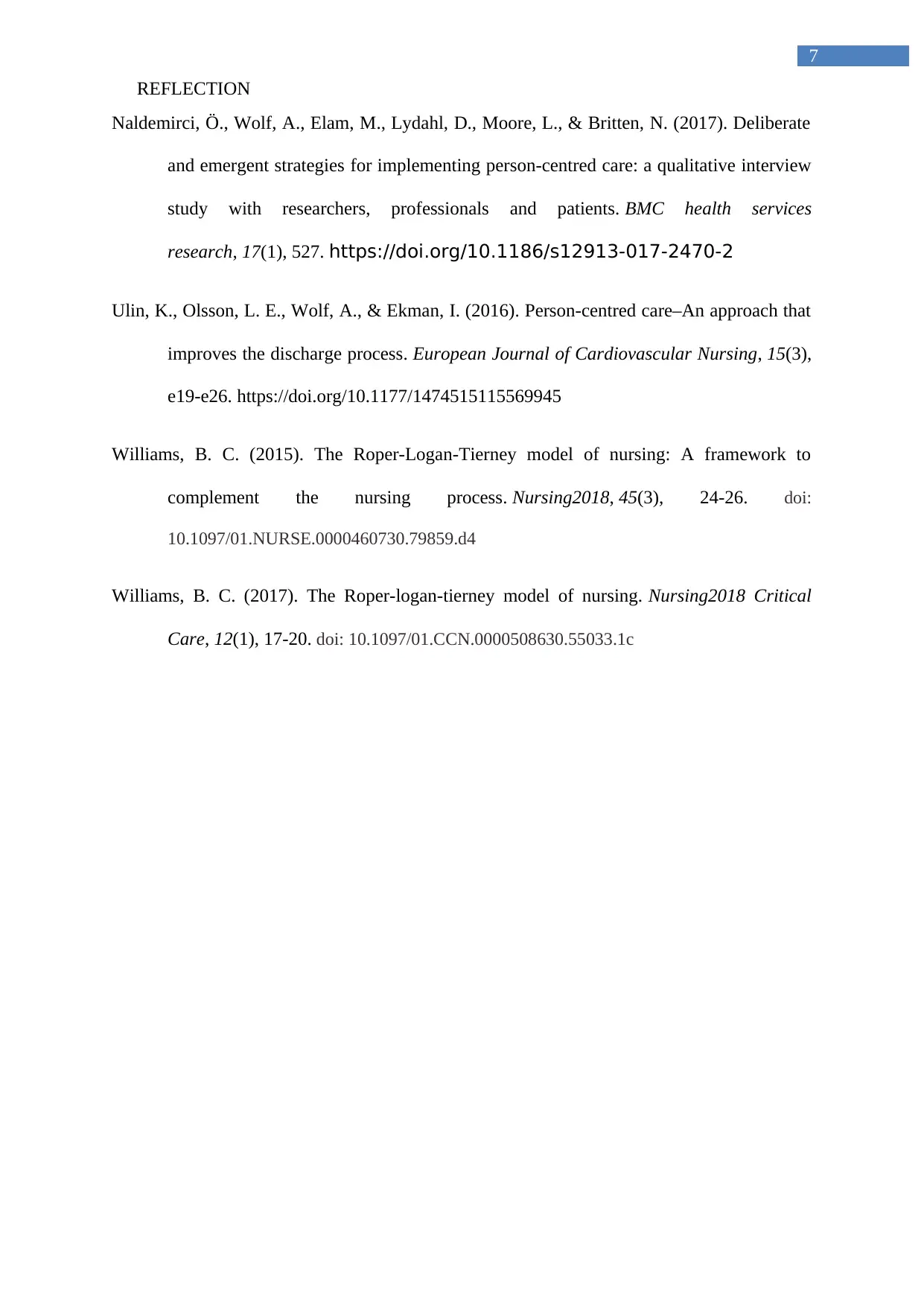
7
REFLECTION
Naldemirci, Ö., Wolf, A., Elam, M., Lydahl, D., Moore, L., & Britten, N. (2017). Deliberate
and emergent strategies for implementing person-centred care: a qualitative interview
study with researchers, professionals and patients. BMC health services
research, 17(1), 527. https://doi.org/10.1186/s12913-017-2470-2
Ulin, K., Olsson, L. E., Wolf, A., & Ekman, I. (2016). Person-centred care–An approach that
improves the discharge process. European Journal of Cardiovascular Nursing, 15(3),
e19-e26. https://doi.org/10.1177/1474515115569945
Williams, B. C. (2015). The Roper-Logan-Tierney model of nursing: A framework to
complement the nursing process. Nursing2018, 45(3), 24-26. doi:
10.1097/01.NURSE.0000460730.79859.d4
Williams, B. C. (2017). The Roper-logan-tierney model of nursing. Nursing2018 Critical
Care, 12(1), 17-20. doi: 10.1097/01.CCN.0000508630.55033.1c
REFLECTION
Naldemirci, Ö., Wolf, A., Elam, M., Lydahl, D., Moore, L., & Britten, N. (2017). Deliberate
and emergent strategies for implementing person-centred care: a qualitative interview
study with researchers, professionals and patients. BMC health services
research, 17(1), 527. https://doi.org/10.1186/s12913-017-2470-2
Ulin, K., Olsson, L. E., Wolf, A., & Ekman, I. (2016). Person-centred care–An approach that
improves the discharge process. European Journal of Cardiovascular Nursing, 15(3),
e19-e26. https://doi.org/10.1177/1474515115569945
Williams, B. C. (2015). The Roper-Logan-Tierney model of nursing: A framework to
complement the nursing process. Nursing2018, 45(3), 24-26. doi:
10.1097/01.NURSE.0000460730.79859.d4
Williams, B. C. (2017). The Roper-logan-tierney model of nursing. Nursing2018 Critical
Care, 12(1), 17-20. doi: 10.1097/01.CCN.0000508630.55033.1c
1 out of 8
Related Documents
Your All-in-One AI-Powered Toolkit for Academic Success.
+13062052269
info@desklib.com
Available 24*7 on WhatsApp / Email
![[object Object]](/_next/static/media/star-bottom.7253800d.svg)
Unlock your academic potential
© 2024 | Zucol Services PVT LTD | All rights reserved.





